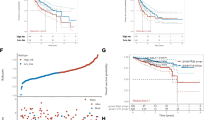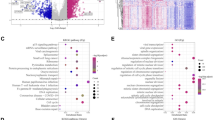Abstract
Background
Recurrence determines the postoperative prognosis with hepatocellular carcinoma (HCC). It is unknown how the liver dysfunction involving organic anion transporter failure causes the occurrence of HCCs. This study was designed to elucidate the link between liver dysfunction and multicentric occurrence (MO) after radical hepatectomy.
Methods
Forty-nine samples of noncancerous liver tissue from HCC patients within the Milan criteria who were treated at our institution between January 2004 and August 2008 were examined as a training set by using genome-wide gene expression analysis. Using the independent 2-institutional cohort of 134 patients between September 2008 and December 2009, we performed a validation study using tissue microarray analysis. Cox proportional hazard regression analyses for MFS were performed to estimate the risk factors.
Results
In the Gene Ontology database (GO:0015711), SLC22A7 expression was the best predictor of MO-free survival [MFS] (Fold, 0.726; P = 0.001). High SLC22A7 gene expression prevented the occurrence of HCC after hepatectomy (odds ratio [OR], 0.2; P = 0.004). Multivariate analyses identified SLC22A7 expression as an independent risk factor (OR, 0.3; P = 0.043). In the validation study, multivariate analyses of MFS identified SLC22A7 expression as an independent risk factor (OR, 0.5; P = 0.012). As judged by gene set enrichment analysis, SLC22A7 down regulation was associated with mitochondrion (P = 0.008) and oxidoreductase activity (P = 0.006). Sirtuin 3 as a regulator of mitochondrial metabolism also determined MFS (P = 0.018).
Conclusions
The mitochondrial pathways may affect SLC 22A7 function to promote the occurrence of HCC. (Word count: 246).


Similar content being viewed by others
Abbreviations
- CI:
-
Confidence interval
- FDR:
-
False discovery rate
- GSEA:
-
Gene set enrichment analysis
- HCC:
-
Hepatocellular carcinoma
- HR:
-
Hazard ratio
- MO:
-
Multicentric occurrence
- NES:
-
Normalized enrichment score
- OR:
-
Odds ratio
References
Yang JD, Roberts LR. Hepatocellular carcinoma: a global view. Nat Rev Gastroenterol Hepatol. 2010;7:448–58.
Schlitt HJ, Schnitzbauer AA. Hepatocellular carcinoma: agents and concepts for preventing recurrence after curative treatment. Liver Transpl. 2011;17(Suppl 3):S10–2.
Utsunomiya T, Shimada M, Imura S, Morine Y, Ikemoto T, Mori M. Molecular signatures of noncancerous liver tissue can predict the risk for late recurrence of hepatocellular carcinoma. J Gastroenterol. 2010;45:146–52.
Japan LCSGo: The general rules for the clinical and pathological study of primary liver cancer (in japanese). 5th ed. Tokyo: Kanehara; 2009. p. 43.
Arii S, Yamaoka Y, Futagawa S, Inoue K, Kobayashi K, Kojiro M, et al. Results of surgical and nonsurgical treatment for small-sized hepatocellular carcinomas: a retrospective and nationwide survey in japan. The liver cancer study group of japan. Hepatology. 2000;32:1224–9.
Hasegawa K, Kokudo N, Imamura H, Matsuyama Y, Aoki T, Minagawa M, et al. Prognostic impact of anatomic resection for hepatocellular carcinoma. Ann Surg. 2005;242:252–9.
Imamura H, Matsuyama Y, Tanaka E, Ohkubo T, Hasegawa K, Miyagawa S, et al. Risk factors contributing to early and late phase intrahepatic recurrence of hepatocellular carcinoma after hepatectomy. J Hepatol. 2003;38:200–7.
Kobayashi A, Miyagawa S, Miwa S, Nakata T. Prognostic impact of anatomical resection on early and late intrahepatic recurrence in patients with hepatocellular carcinoma. J Hepatobiliary Pancreat Surg. 2008;15:515–21.
Kudo A, Kashiwagi S, Kajimura M, Yoshimura Y, Uchida K, Arii S, et al. Kupffer cells alter organic anion transport through multidrug resistance protein 2 in the post-cold ischemic rat liver. Hepatology. 2004;39:1099–109.
Sekine T, Cha SH, Tsuda M, Apiwattanakul N, Nakajima N, Kanai Y, Endou H. Identification of multispecific organic anion transporter 2 expressed predominantly in the liver. FEBS Lett. 1998;12:179–82.
Fork C, Bauer T, Golz S, Geerts A, Weiland J, Del Turco D, et al. Oat2 catalyses efflux of glutamate and uptake of orotic acid. Biochem J. 2011;436:305–12.
Laconi E, Vasudevan S, Rao PM, Rajalakshmi S, Pani P, Sarma DS. The development of hepatocellular carcinoma in initiated rat liver after a brief exposure to orotic acid coupled with partial hepatectomy. Carcinogenesis. 1993;14:2527–30.
Takayama T, Makuuchi M, Hirohashi S, Sakamoto M, Yamamoto J, Shimada K, et al. Early hepatocellular carcinoma as an entity with a high rate of surgical cure. Hepatology. 1998;28:1241–6.
Enomoto A, Takeda M, Shimoda M, Narikawa S, Kobayashi Y, Yamamoto T, et al. Interaction of human organic anion transporters 2 and 4 with organic anion transport inhibitors. J Pharmacol Exp Ther. 2002;301:797–802.
Hallows WC, Yu W, Smith BC, Devries MK, Ellinger JJ, Someya S, et al. Sirt3 promotes the urea cycle and fatty acid oxidation during dietary restriction. Mol Cell. 2011;41:139–49.
Hirschey MD, Shimazu T, Goetzman E, Jing E, Schwer B, Lombard DB, et al. Sirt3 regulates mitochondrial fatty-acid oxidation by reversible enzyme deacetylation. Nature. 2010;464:121–5.
Hoshida Y, Villanueva A, Kobayashi M, Peix J, Chiang DY, Camargo A, et al. Gene expression in fixed tissues and outcome in hepatocellular carcinoma. N Engl J Med. 2008;359:1995–2004.
Tanaka S, Mogushi K, Yasen M, Ban D, Kudo A, Arii S, et al. Oxidative stress pathways in noncancerous human liver tissue to predict hepatocellular carcinoma recurrence: a prospective, multicenter study. Hepatology. 2011;54:1273–81.
Marra M, Sordelli IM, Lombardi A, Lamberti M, Tarantino L, Giudice A, et al. Molecular targets and oxidative stress biomarkers in hepatocellular carcinoma: an overview. J Transl Med. 2011;9:171.
Su GM, Sefton RM, Murray M. Down-regulation of rat hepatic microsomal cytochromes p-450 in microvesicular steatosis induced by orotic acid. J Pharmacol Exp Ther. 1999;291:953–9.
Zhang WV, Ramzan I, Murray M. Impaired microsomal oxidation of the atypical antipsychotic agent clozapine in hepatic steatosis. J Pharmacol Exp Ther. 2007;322:770–7.
Chen C, Han YH, Yang Z, Rodrigues AD. Effect of interferon-alpha2b on the expression of various drug-metabolizing enzymes and transporters in co-cultures of freshly prepared human primary hepatocytes. Xenobiotica. 2011;41:476–85.
Locker GJ, Mader RM, Steiner B, Wenzl E, Zielinski CC, Steger GG. Benefit of interferon-alpha2b in a patient with unresectable hepatoma and chronic infection with hepatitis c virus. Eur J Gastroenterol Hepatol. 2000;12:251–3.
Kudo A, Ban D, Aihara A, Irie T, Ochiai T, Nakamura N, Tanaka S, Arii S. Decreased Mrp2 transport in severe macrovesicular fatty liver grafts. J Surg Res. 2012;178(2):915–21.
Ban D, Kudo A, Sui S, Tanaka S, Nakamura N, Ito K, et al. Decreased mrp2-dependent bile flow in the post-warm ischemic rat liver. J Surg Res. 2009;153:310–6.
Norimizu S, Kudo A, Kajimura M, Ishikawa K, Taniai H, Suematsu M, et al. Carbon monoxide stimulates mrp2-dependent excretion of bilirubin-ixalpha into bile in the perfused rat liver. Antioxid Redox Signal. 2003;5:449–56.
Sui S, Kudo A, Suematsu M, Tanaka S, Ito K, Arii S, et al. Preservation solutions alter mrp2-dependent bile flow in cold ischemic rat livers. J Surg Res. 2010;159:572–81.
Rao PM, Nagamine Y, Roomi MW, Rajalakshmi S, Sarma DS. Orotic acid, a new promoter for experimental liver carcinogenesis. Toxicol Pathol. 1984;12:173–8.
Laurier C, Tatematsu M, Rao PM, Rajalakshmi S, Sarma DS. Promotion by orotic acid of liver carcinogenesis in rats initiated by 1,2-dimethylhydrazine. Cancer Res. 1984;44:2186–91.
Denda A, Laconi E, Rao PM, Rajalakshmi S, Sarma DS. Sequential histopathological analysis of hepatocarcinogenesis in rats during promotion with orotic acid. Cancer Lett. 1994;82:55–64.
Zhang YY, Zhou LM. Sirt3 inhibits hepatocellular carcinoma cell growth through reducing mdm2-mediated p53 degradation. Biochem Biophys Res Commun. 2012;423:26–31.
Jeffers LJ, Dubow RA, Zieve L, Reddy KR, Livingstone AS, Neimark S, et al. Hepatic encephalopathy and orotic aciduria associated with hepatocellular carcinoma in a noncirrhotic liver. Hepatology. 1988;8:78–81.
Acknowledgments
This work was supported by a Health and Labour Sciences Research Grant (H20-Kanen-Ippan-001) from the Ministry of Health, Labour, and Welfare of Japan and a Grant-in Aid for Scientific Research from the Ministry of Education, Culture, Sports, Science, and Technology of Japan. The authors thank Hiromi Ohnari and Ayumi Shioya for clerical and technical assistance.
Conflict of interest
The authors declare that they have no conflict of interest.
Author information
Authors and Affiliations
Corresponding author
Additional information
Accession number of repository for expression microarray data: GSE40873.
Electronic supplementary material
Below is the link to the electronic supplementary material.
535_2013_791_MOESM2_ESM.tif
Supplementary figure. 1 Sirtuin 3 related mechanisms and the correlation between SLC22A7 transports and mitochondrial mechanisms. Note the orotic acid regulated by sirtuin 3 is transported through SLC22A7. Sirtuin 3 regulates antioxidant pathway, acetate metabolism, and beta-oxidation. (TIFF 3085 kb)
535_2013_791_MOESM3_ESM.eps
Supplementary figure 2. GSEA evaluation of gene-expression profile associated with SLC22A7. Heat map of genes in the sirtuin 3-related gene set. (EPS 894 kb)
535_2013_791_MOESM4_ESM.tif
Supplementary figure 3. GSEA evaluation of gene-expression profile associated with SLC22A7. Note the enrichment plot of sirtuin 3 related gene set (P = 0.008; FDR = 0.008; NES = 1.786). (TIFF 3924 kb)
Rights and permissions
About this article
Cite this article
Kudo, A., Mogushi, K., Takayama, T. et al. Mitochondrial metabolism in the noncancerous liver determine the occurrence of hepatocellular carcinoma: a prospective study. J Gastroenterol 49, 502–510 (2014). https://doi.org/10.1007/s00535-013-0791-4
Received:
Accepted:
Published:
Issue Date:
DOI: https://doi.org/10.1007/s00535-013-0791-4




